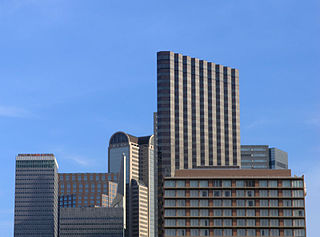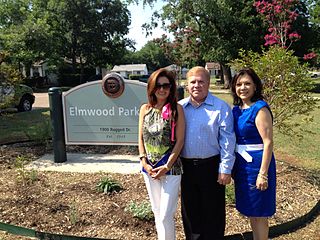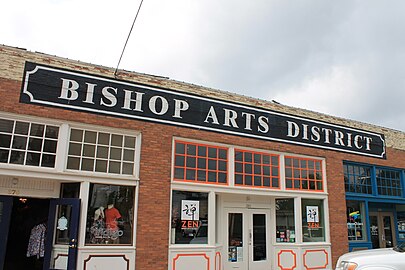
Oak Cliff is an area of Dallas, Texas, United States that was formerly a separate town in Dallas County; established in 1886 and annexed by Dallas in 1903, Oak Cliff has retained a distinct neighborhood identity as one of Dallas' older established neighborhoods.

The Texas Theatre is a movie theater and Dallas landmark located in the Oak Cliff neighborhood of Dallas, Texas. It gained historical significance on November 22, 1963, as the location of Lee Harvey Oswald's arrest over the suspicion he was the killer of Dallas Police Officer J. D. Tippit and President John F. Kennedy. Today, it hosts a mix of repertory cinema and special events.
Winnetka Heights is one of the oldest and largest historical districts in the Oak Cliff section of Dallas, Texas (USA). The district is bounded by Davis Street on the north, 12th Street on the south, Willomet Avenue on the east and Rosemont Avenue on the west. Established in 1910, Winnetka Heights consists of early 20th century wood-frame houses.

The Bishop Arts District is a shopping and entertainment district in north Oak Cliff, Dallas, Texas (USA), near the intersection of N. Bishop Ave and Davis Street. About two miles southwest of Downtown Dallas, the Bishop Arts District is home to a variety of independent boutiques, restaurants, bars, coffee shops, and art galleries.

Lake Cliff is a neighborhood in the northern part of the Oak Cliff area of Dallas, Texas (USA). It surrounds Lake Cliff, a small freshwater lake. From 1906 to 1913, Oak Cliff was home to an amusement park that, according to its founders, outdid Coney Island. Lake Cliff Park featured a 2,500-seat theater, an 18,000-square-foot roller-skating rink, a roller coaster, Japanese village, mechanical swings, and water rides. Dallasites could take a streetcar link straight to its front door and marvel at the park’s electrical lighting. Today, visitors can still spy remnants of the brick-lined channel.

Brightwood is a neighborhood in the northwestern quadrant of Washington, D.C. Brightwood is part of Ward 4.

The City Center District is an area in north-central downtown Dallas, Texas (USA). It lies south of the Arts District, north of the Main Street District, northwest of Deep Ellum, southwest of Bryan Place and east of the West End Historic District. The district contains a large concentration of downtown commercial space which prior to 1950 had been concentrated along Main Street. The district also contains remnants of Theatre Row, the historical entertainment area along Elm Street which contained theatres such as the Majestic Theatre.

University Heights is a neighborhood in San Diego, California, centered on Park Boulevard and Adams Avenue. University Heights is bounded on the west and north by the edge of the mesa, the southern boundary is Lincoln Avenue, and the eastern boundary is Texas Street. The area is filled with a number of restaurants, coffee shops, boutiques, and artist studios primarily on Park Boulevard and Adams Avenue. Live entertainment can be found most nights. Adjacent to Hillcrest, Normal Heights and North Park, additional restaurants, bars, coffee shops, and night clubs are within easy reach.

The Swiss Avenue Historic District is a residential neighborhood in East Dallas, Dallas, Texas (USA). It consists of installations of the Munger Place addition, one of East Dallas' early subdivisions. The Swiss Avenue Historic District is a historic district of the city of Dallas, Texas. The boundaries of the district comprise both sides of Swiss Avenue from Fitzhugh Street, to just north of La Vista, and includes portions of Bryan Parkway. The District includes the 6100-6200 blocks of La Vista Drive, the west side of the 5500 block of Bryan Parkway the 6100-6300 blocks of Bryan Parkway, the east side of the 5200-5300 block of Live Oak Street, and the 4900-6100 blocks of Swiss Avenue. The entire street of Swiss Avenue is not included within the bounds of the Swiss Avenue Historic District. Portions of the street run through Dallas' Peaks Suburban Addition neighborhood and Peak's Suburban Addition Historic District. 5215 Swiss was built in 1914 and was the home of J. P. Cranfield

Kidd Springs is a neighborhood in the North Oak Cliff area of Dallas, Texas (USA). James Kidd purchased land in the area in the 1870s which included the spring now bearing his name.

King's Highway is located in the Oak Cliff area of Dallas, Texas (USA). The district is bounded by Stewart Drive on the north, Davis Street on the south, Tyler Street on the east and Mary Cliff Road on the west. It is in Dallas Council District 3.
L.O. Daniel is a neighborhood in northern Oak Cliff, Dallas, Texas.
Stevens Park Village is a neighborhood in northern Oak Cliff, Dallas, Texas (USA), named for its developer, John P. Stevens.

Elmwood is a residential neighborhood in central Oak Cliff, within Dallas, Texas, composed of tudor cottages, craftsman bungalows and ranch-style homes built mostly in the 1920s through the 1950s surrounding a central greenbelt along the limestone banks of Cedar Creek (Texas).

Uptown is a PID and a dense neighborhood in Dallas, Texas. Uptown is north of and adjacent to downtown Dallas, and is bordered by US 75 on the east, N Haskell Avenue on the northeast, the Katy Trail on the northwest, Bookhout Street and Cedar Springs Road on the west, N Akard Street on the southwest and Spur 366 on the south.

Grapevine Commercial Historic District is located in Grapevine, Texas.

The Wilson Block is a historic district located in east Dallas, Texas and was one of the first residential developments in Dallas. It was added to the National Register of Historic Places in 1978. The houses have been restored and are maintained to preserve their turn-of-the-century Victorian revival style architecture. The Wilson Block includes 4 of the original single-family dwellings located at what is now 2902, 2906, 2910 and 2922 Swiss Ave. The District encompasses a city block, 95,000 square feet (8,800 m2), bounded by Swiss Avenue, Floyd, Oak, and Liberty Streets.

The Avondale Historic District in Alexander City, Alabama, is a 750 acres (3.0 km2) historic district which was listed on the National Register of Historic Places in 2005.

The Tenth Street Freedman's Town is a historic African American community in the Oak Cliff section of Dallas, Texas. A freedmen's town is a community settled by formerly enslaved people who were emancipated during and after the American Civil War. The freedmen's town that became known as Tenth Street began near the confluence of Cedar Creek and Cedar Creek Branch, at the foot of an African American burial ground dating back to 1846. The name "Tenth Street" became associated with the community in 1887, when John Scarborough Armstrong and Thomas Lafayette Marsalis platted the town of Oak Cliff.

Stevens Park Golf Course is a public golf course in the Kessler area of Dallas, Texas United States. Often described as the "Little Augusta" of North Texas, the course is located just west of Downtown Dallas and nestled between the Stevens Park Estates and Kessler Park neighborhoods.
























